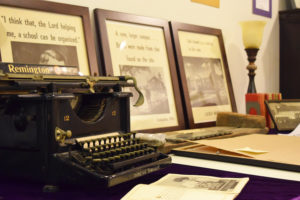“That’s my favorite picture of Willard.” Laura Habacker stands outside the front door of her office, gesturing at the larger-than-life portrait of Willard Houghton that hangs on the library walls. Her office is surprisingly warm and welcoming, full of light and crowded with row upon row of gray archival boxes, majestic old typewriters, and Dictaphones. “I’ve been putting signs up so people can find us!” Habecker says.
 While most archives are traditionally maintained to answer the questions and support the projects of the President, Habecker envisions a more open atmosphere. “This stuff is here to remind all of us why we do this,” she said. Still, only two keys to the room exist. One belongs to Habecker, and the other to President Mullen.
While most archives are traditionally maintained to answer the questions and support the projects of the President, Habecker envisions a more open atmosphere. “This stuff is here to remind all of us why we do this,” she said. Still, only two keys to the room exist. One belongs to Habecker, and the other to President Mullen.
As part of an ongoing relationship with the New York Heritage Digital Collections project, Habecker also spends hours each week scanning tintypes and black-and-white photographs of the college and the towns, landscape, and people of the Genessee Valley. “I have a much broader perspective because I didn’t attend here,” she says. “I see the history with very different eyes than anyone else who’s been in this position.”
Habecker, who joined the library staff as resident archivist last year, has a cheerful smile and a youthful, contagious enthusiasm. “I love my job!” she says. “Every single day I get to go home with a cool story.” On several occasions last year, she says, she was so immersed in a scribbled manuscript or an unidentified photograph that she had to be reminded to pick up her son after school.
She has Willard Houghton’s treasured “pocket manual,” dated 1890, which contains sermon notes and Scripture passages and is positively riddled with typos. “He couldn’t spell for anything,” Habacker explains with a rueful smile.
Fascinating stories also abound in boxes sent from alumni and former faculty. “Can you get the scrapbook?” Habecker asks Jessica Robinson ’18, a library student worker who has been helping to organize the archives since Habecker joined the staff.
Robinson returns with a delicate green and red notebook, carefully wrapped in parchment paper. Inside, documented by fragile scraps of paper and a loose, carefree script, are the remnants of a young female student’s life. Clippings from the jokes section of the Houghton Star (an example: A playbill for something called “Yuffalo Yills Wild And Wooly Circumambulating Circus Abomination,” featuring pink lemonade and a “Great Moral Drama” and whose staff was “not responsible for and pick-pocketing” that occurred during the show.
Hidden throughout the archives are sometimes surprising, always winsome reminders of the many ways in which these students were like us. One of these is the display of classic Houghton dry wit. In an entry entitled “In Freshman Math,” the student recounts a class period in which then-professor James S. Luckey (later the college’s second president) proposed enhancing Oberlin applications and preparing for advanced physics classes by studying analytic geometry, trigonometry, and calculus—“thus killing two birds with one stone.” Another student, described as “doleful,” replies: “It’ll probably kill three.”
Several pages later, a group of bonneted girls stare somberly toward the camera in one photo and then erupt into raucous, goofy giggles in another. Another photo finds them arranged around a favorite tree. “They called themselves the Allen Family,” Habecker says. On the facing page appear the girls’ names and nicknames, laid out together like the cast list of a play. They called one of the girls “Grandpa” and another one “Aunt.” I can’t help thinking of the many students I have seen cheekily sporting “Houghton Dad” or “Houghton Grandma” T-shirts.
Yet there are a few sobering reminders that, in many ways, they were not so like us. Tucked into a cedar chest in the back of the room, the college’s war flag is splashed with stars for every student who joined the army—along with three small triangles for the Houghton students who died in battles overseas.
In coming years, Habecker hopes to engage even more of the student body in exploring the college’s history. “The whole focus of the school is the student, so I want the students represented,” she said. “If it’s not for the students, then why are we here?”
To that end, the college archives are now open to students between 1 and 4 p.m. every Friday afternoon. Students are also invited to join in the adventure by sorting through documents, scanning and repairing photos, and moving records into acid-free storage.
Says Habecker, a gigantic grin on her face: “I’m willing to work with anybody!”
